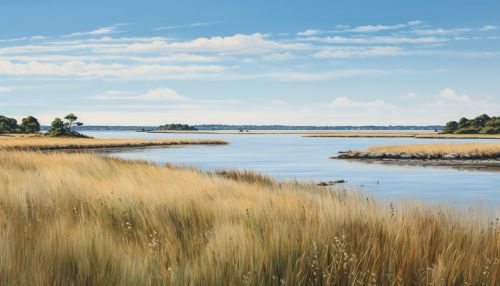Salt Marsh Ecology and Sea Level Rise
Introduction
Salt marsh ecology is a specialized field of marine biology that focuses on the complex interactions between the organisms that inhabit these unique coastal ecosystems and their environment. Salt marshes, which are coastal wetlands that are flooded and drained by salt water brought in by the tides, play a crucial role in maintaining biodiversity, protecting coastlines, and sequestering carbon. However, they are increasingly threatened by sea level rise, a consequence of global climate change.
Salt Marsh Ecology
Salt marshes are characterized by grassy vegetation that is tolerant to the high salinity conditions brought about by the regular influx of seawater. They are home to a diverse array of organisms, from microscopic bacteria and algae to larger animals such as birds, fish, and mammals. The ecological dynamics of salt marshes are complex and involve intricate food webs and nutrient cycles.
Flora
The dominant vegetation in salt marshes is typically composed of salt-tolerant plants, known as halophytes. These include grasses, sedges, and rushes, as well as a variety of other plant species that have adapted to the harsh conditions of the marsh environment. The vegetation plays a crucial role in the marsh ecosystem, providing habitat and food for a variety of organisms, stabilizing the marsh soil, and playing a role in nutrient cycling.
Fauna
Salt marshes are teeming with animal life. They serve as important breeding grounds for many species of fish and shellfish, including commercially important species. They also provide habitat for a variety of bird species, some of which are migratory and use the marshes as stopover points during their long journeys. Invertebrates, such as snails, crabs, and insects, are also abundant in salt marshes and play important roles in the marsh ecosystem.
Nutrient Cycling
Salt marshes play a crucial role in nutrient cycling. They act as natural filters, trapping sediments and pollutants that are carried in by the tides, and breaking them down through biological processes. The vegetation in the marshes also plays a role in nutrient cycling, taking up nutrients from the soil and water and releasing them back into the environment when they die and decompose.
Sea Level Rise and Salt Marshes
One of the major threats to salt marshes is sea level rise, a consequence of global climate change. As sea levels rise, salt marshes are at risk of being flooded and eroded away. This can lead to the loss of these valuable ecosystems, with serious consequences for biodiversity, coastal protection, and carbon sequestration.
Impact on Salt Marsh Ecology
Sea level rise can have profound impacts on the ecology of salt marshes. As the marshes are flooded, the vegetation may be drowned, leading to a loss of habitat and food for the organisms that rely on it. The changes in water levels can also disrupt the delicate balance of the marsh ecosystem, affecting nutrient cycling and the complex food webs that exist in these habitats.
Adaptation and Resilience
Despite the threats posed by sea level rise, salt marshes have shown a remarkable ability to adapt and be resilient. They have natural mechanisms that allow them to cope with changes in sea level, such as the ability to build up their soil levels through the accumulation of organic matter and sediments. However, the rate of sea level rise may outpace the ability of the marshes to adapt, leading to their eventual loss.
Conservation and Management
Given the importance of salt marshes and the threats they face from sea level rise, there is a need for effective conservation and management strategies. These include protecting existing marshes, restoring degraded ones, and creating new ones where possible. It also involves managing the impacts of human activities, such as pollution and development, that can exacerbate the effects of sea level rise.
See Also
Categories


